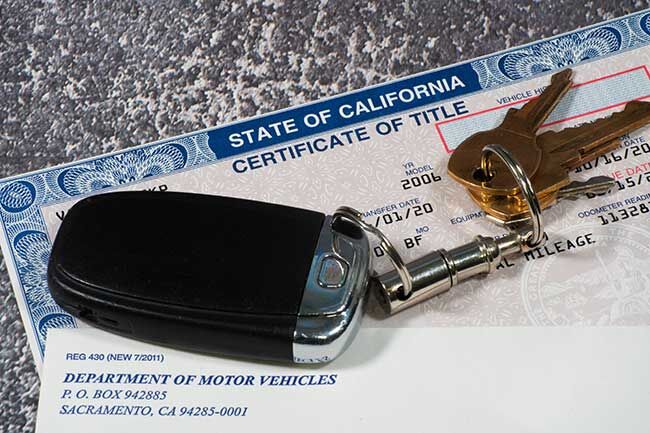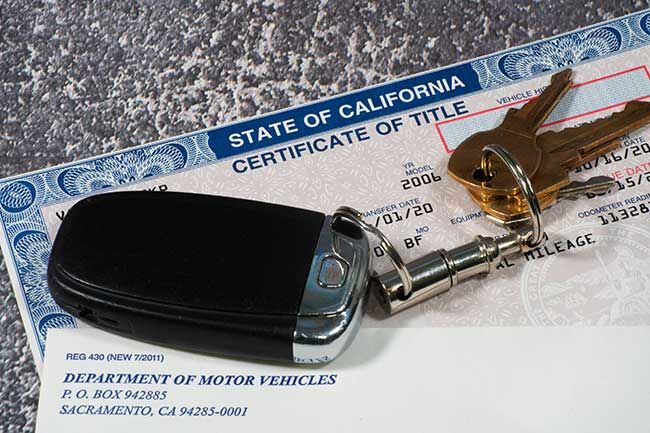
How to Transfer a Vehicle Title Online in California
This post contains affiliate links to products and services. We may receive compensation when you click on links.
Need to transfer your California vehicle title? You’ve come to the right place. Everything can be handled online, and there are two ways you can transfer your car’s title. You can do so with Car Registration or with the California DMV. We’ll discuss both options, so you can make an educated decision and choose which option suits you best.
Transferring Your Car Title with Car Registration
When you transfer your car’s title with Car Registration, you will need the following information to get started:
- License plate number
- The last 5 digits of your vehicle identification number (VIN)
- Zip code of the location where the car is registered
- Email address
There are other steps in the CA car title transfer process that you will be guided through to ensure you have everything you need to transfer your car title. Be advised that the services provided by Car Registration are paid services. Although no one looks forward to paying fees, it’s better to pay the required fees now than wait later to transfer your car’s title and possibly have to pay additional fees or fines.
Transferring Your Car Title with Your Local California DMV Branch
To prove ownership of a vehicle, you must have a valid, up-to-date, and accurate California Certificate of Title.
Transferring a California Car Title
Anytime the ownership of a vehicle or vessel changes, CA DMV records must be updated within 10 days and the California Certificate of Title must be transferred to the new owner. A change in ownership can change due to any of the following:
- Sale, gift, or donation
- Adding or deleting the name of an owner
- Inheritance
- Satisfaction of lien (full payment of a car loan)
To transfer a California car title, you will need the following:
- Either the California Certificate of Title or an Application for Replacement or Transfer of Title (Form REG 227) if the car title is missing.
- The signature(s) of seller(s) and lienholder (if any)
- The signature(s) of the buyer(s)
- Payment for the transfer fee
Depending on the type of transfer, you may be required to complete and submit additional forms. You must submit your California title transfer paperwork and fee(s), at any to a CA DMV branch or mail it to the following address:
California Department of Motor Vehicles
P.O. Box 942869
Sacramento, CA 94269
Rush Title Processing in California
You can request an expedited title by asking for rush title processing for an additional fee. If you plan on requesting a rush title, it’s a good idea to call before visiting the CA DMV and ask about all applicable fees that you are required to pay.
California Title Transfer Fees
Depending on the type of transfer you’re doing, you may be required to pay the following fees:
- Replacement title
- Transfer
- Use tax (based on the buyer’s county of residency)
- Registration
- Penalties
You can view the full list of California fees here. Renewal fees and parking or toll violation fees are not required to be paid to issue a replacement California Certificate of Title.
What California Title Transfer Forms Do I Need?
Here is a list of forms that may be required when you are transferring ownership of a vehicle or vessel.
- Application for Replacement or Transfer of Title (Form REG 227)
- Vehicle/Vessel Transfer and Reassignment (Form REG 262). You must call the CA DMV’s automated voice system at 1-800-777-0133 to have the form mailed to you.
- Statement of Facts (Form REG 256)
- Lien Satisfied/Title Holder Release (Form REG 166)
- Notice of Transfer and Release of Liability
- Smog Certification
- Vehicle Emission System Statement (Smog) (Form REG 139)
- Declaration of Gross Vehicle Weight (GVW)/Combined Gross Vehicle Weight (CGW) – (Form REG 4008)
- Affidavit for Transfer without Probate (Form REG 5)
- Bill of Sale (Form REG 135)
- Verification of Vehicle (Form REG 31)
Other Title Transfers in California
There are different situations when you are required to transfer ownership of a vehicle.
Transferring Vehicle Ownership Between a Buyer and a Seller
When you purchase a new car from a dealership, the dealer will handle the required paperwork and you will receive your title from the CA DMV in the mail.If you purchase a vehicle in a private sale (the sale of a car between two individuals), you must also transfer ownership of the car by transferring the car’s title. If you have the California Certificate of Title for the car, the car’s seller must sign the title to release ownership of the vehicle. The car’s buyer must take the signed title to a CA DMV branch to apply to transfer ownership of the car.If you don’t have the California Certificate of Title, you must use an Application for Replacement or Transfer of Title (Form REG 227) to transfer ownership of the vehicle. If a lien release is required, it must be notarized. The car’s buyer must take the completed form to a CA DMV branch to be issued a new CA registration and car title.
Additional Steps Car Buyers and Sellers Must Take When a Vehicle’s Ownership is Transferred
Whether you’re the car’s seller or the buyer of a car, there are additional steps you are required to take to complete the California title transfer process.
Additional Steps for the Car Seller
As the car’s seller, you may be required to complete the following:
- Disclosure Odometer Mileage Reading (this is found on the car’s title or a Vehicle/Vessel Transfer and Reassignment (Form REG 262) unless the vehicle is at least 10 years old, a commercial vehicle with a GVW or CGW of more than 16,000 lbs., or a new vehicle that is transferring owners before its first retail sale by a dealer.
- Complete a Notice of Transfer and Release of Liability (NRL) within 5 days of releasing ownership. Make sure you keep a copy for your records.
Once you give the buyer the required documents and the CA DMV receives the completed NRL, your part of the transfer process is complete. Be advised that if the vehicle has been sold more than once with the same title, a REG 262 is required from each seller.
Additional Steps for the Car Buyer
If you’re the buyer of a car, you will need to do the following: Check the registration card for the following:
- Check the registration card for the following:
- Current registered owner(s), and pay attention to how the names are joined (“and/or”), and the lienholder/legal owner (if any)
- License plate number
- Vehicle identification number (VIN)
- Make, model, and year of the car
- The expiration date
- Title brands, if any (such as a salvaged car)
- Words “Nontransferable/No California Title Issued.” that indicates a California title was not issued and a REG 227 can NOT be used
- Obtain a smog inspection (if applicable)
After you provide the CA DMV with the proper documents and fees, the vehicle record is updated to reflect the change of ownership and a registration card will be issued. A new title is issued from CA DMV headquarters within 60 calendar days.
Transferring Vehicle Ownership Between Family Members
To transfer a vehicle between family members, you must submit the following:
- The California Certificate of Title that is properly signed or endorsed on line 1 by the registered owner(s) shown on the title. You must also complete the new owner information on the back of the title and sign it.
- A Statement of Facts (Form REG 256) for use tax and smog exemption (if applicable)
- Odometer disclosure – required for vehicles that are less than 10 years old
- Payment for the applicable transfer fee(s)
Transferring a Vehicle from an Individual to an Estate in California
In California, you can transfer a vehicle from an individual to the estate of that individual without signatures on the Certificate of Title. To do so, you must submit the following:
- The California Certificate of Title. On the back of the title, the new owner section must show “Estate of (name of individual)” and their address. Any legal owner/lienholder that is named on the front of the title must be re-entered on the back of the title.
- A Statement of Facts (Form REG 256) confirming the owner is deceased and Letters of Testamentary have not been issued. The individual who is completing the statement must indicate their relationship to the deceased.
- Payment for the transfer fee
Use tax and a smog certification are not required when you are transferring the ownership of a vehicle from an individual to an estate.
Transfer a Vehicle from a Deceased Owner to an Heir (Without Probate)
Vehicle ownership can be transferred to a deceased owner’s heir 40 days after the owner’s death as long as the value of the deceased’s property in California does NOT exceed the following:
- $150,000 if the deceased died before 1/1/20
- $166,250 if the deceased died on or after 1/1/20
If the heir will be the new owner, you must submit the following to a CA DMV branch:
- The California Certificate of Title. The heir must sign the deceased registered owner’s name and countersign on line 1. The heir should complete and sign the back of the title.
- Affidavit for Transfer without Probate (Form REG 5) must be completed and signed by the heir.
- An original or certified copy of the death certificate of all deceased owners
- Odometer disclosure for vehicles that are less than 10 years old
- Payment for the transfer fee
If the heirs prefer to sell the vehicle, the buyer must also (in addition to the items above), complete the following:
- Bill of Sale (Form REG 135) from the heir to the buyer
- Transfer fee (two transfer fees are required in this scenario)
California Vehicle Title Transfer FAQ
If there comes a time that you have to transfer a vehicle title in California, you may have a few questions. Here are answers to the questions that are commonly asked.Q. Does the REG 227 need to be notarized?If the vehicle has a legal owner or lienholder, section 5 of form REG 227 MUST be notarized. However, if the registration does NOT show a legal owner or lienholder, notarization of this form is NOT required.Q. How do I locate an out-of-business legal owner?If you need help finding the lienholder on your vehicle’s title, you can check for the following types of business that may have gone out of business, merged, changed their name, or been acquired by another financial institution.
Q. My registration card says “Nontransferable/No California Title Issued.” Can Form REG 227 be used?No. You are required to obtain a title from the state where the vehicle was previously titled. If you’re unable to get a title from that state, you must provide documentation that they can’t issue a title. You may be required to have a motor vehicle bond.


















